The Art Detective
The Met’s ‘Siena’ Blockbuster Has Priceless Loans. How Did It Come Together?
It took new technology, years of collaboration, and major investments to deliver a show for the ages. 'This is not a grab and go,' one curator said.
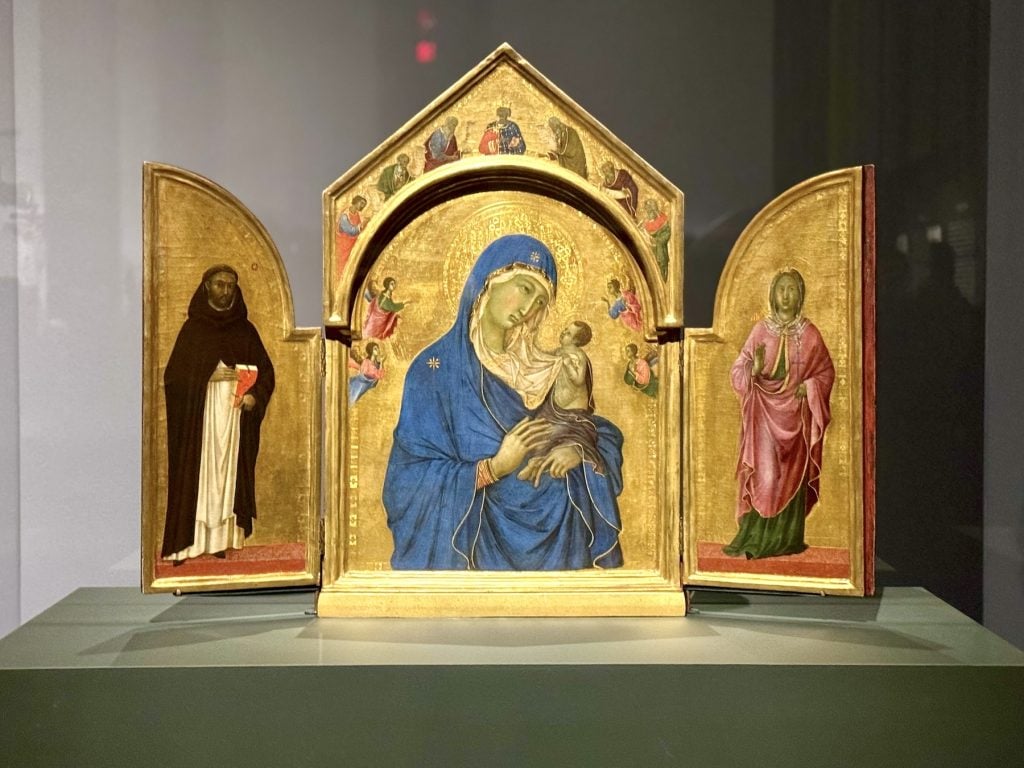
While the contemporary art tribe was in London for Frieze Week, I found myself magnetically drawn to a much earlier chapter of art history here in New York. The magnet was a seductively titled new exhibition, “Siena: The Rise of Painting, 1300-1350,” at the Metropolitan Museum of Art.
I have fond memories of visiting Siena with my husband and kids in the summer of 2023: Its zebra-striped Duomo and terracotta rooftops, poorly air-conditioned museums filled with an astonishing number of gold-ground paintings, stern-looking saints wrapped in dizzyingly patterned textiles. It was a spellbinding experience.
This week, I had a similar feeling at the Met’s show. There, inside darkened rooms, 95 treasures glow, ranging from a jaw-dropping altarpiece brought to New York from a church in Arezzo, Italy, to a 7-inch carved ivory Virgin Mary. The undisputed star of the exhibition is Duccio di Buoninsegna, a Sienese master at the start of the 14th century.
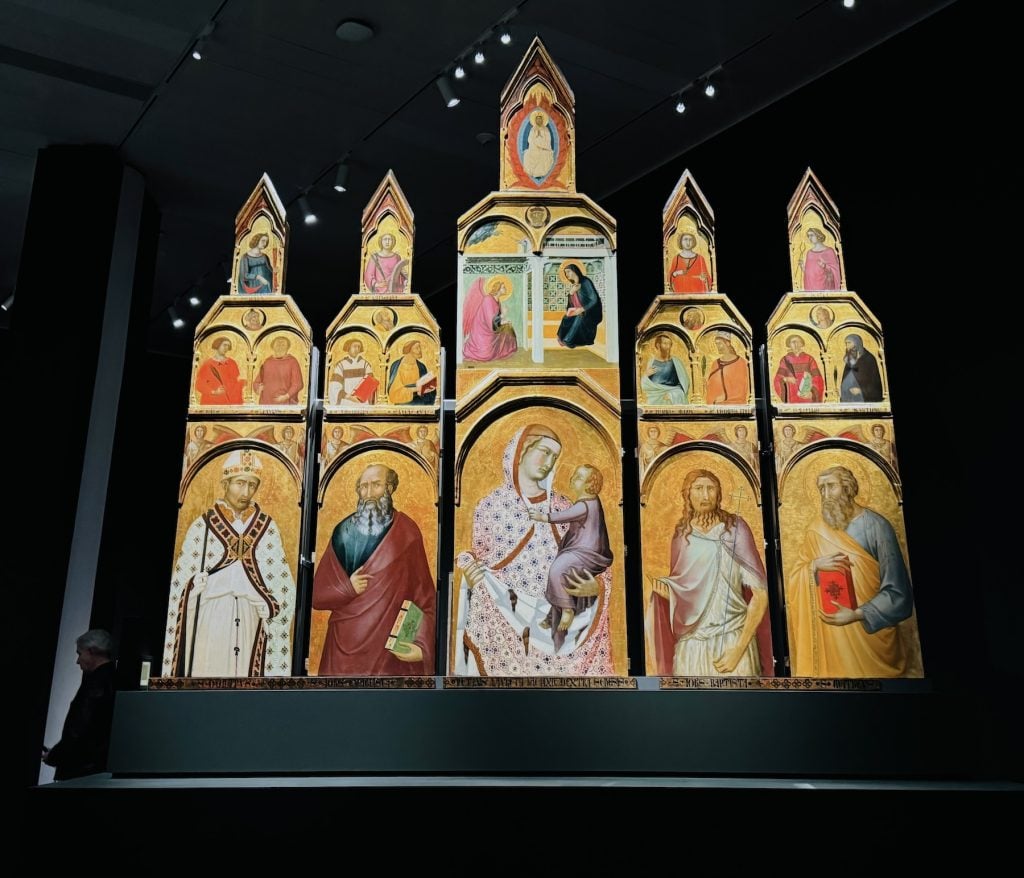
Pietro Lorenzotti, Tarlati Polyptych (1320) in “Siena: The Rise of Painting, 1300-1350.” Photo by Ben Davis.
Better known as Duccio, he was a rebel, tax evader, and a big-deal painter. Put simply, he was the bridge between the flatness of Byzantine icon painting and the perspective of the early Renaissance. In 2004, the Met shelled out $45 million for an 11-by-8-inch gold-ground panel, Madonna and Child (ca. 1290–1300), the most that the nation’s biggest museum had ever paid for an artwork.
“The first slide in an Art History 101 course is a Duccio,” Philippe de Montebello, the Met’s director, told the New York Times back then. “He was one of the founders of Western art.”
The current exhibition includes 13 paintings by the artist, an astounding number considering how few have survived. All of them are in major public institutions. The Met’s pride, Madonna and Child, is the first artwork you see. Other paintings hail from the Museo Thyssen-Bornemisza in Madrid, the Kimbell Art Museum in Forth Worth, Tex., the National Gallery of Art in Washington, D.C., the National Gallery in London, and the Frick Collection, just down the street.
“They are not the works you normally just lend,” said the Met’s Stephan Wolohojian, who co-curated the exhibition with colleagues from London’s National Gallery and the Courtauld Institute of Art. “They are the cornerstones of the collections in which they are found. And they are very fragile.”
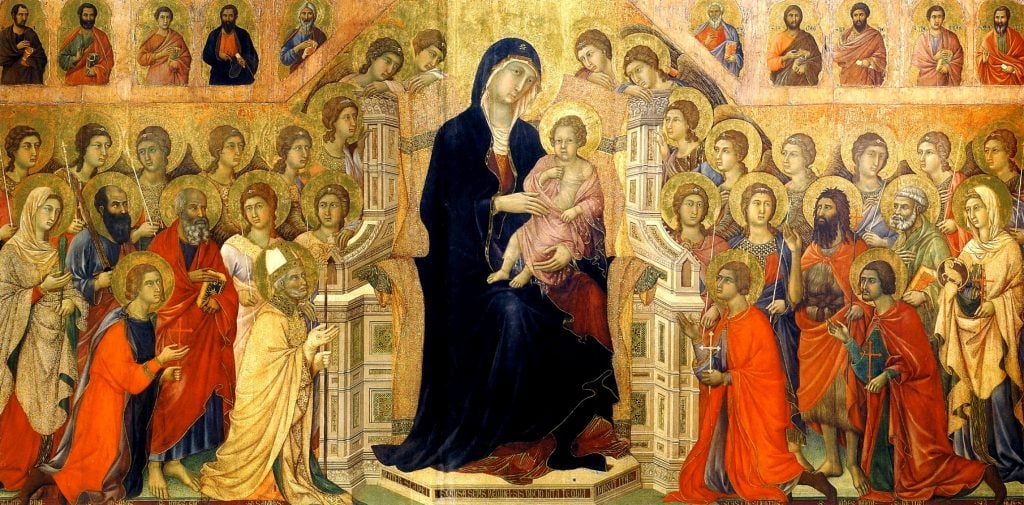
Duccio di Buoninsegna, Maestà Altarpiece (ca. 1308–1311). Collection of Siena Cathedral.
Until recent technological advances in conservation and shipping, these masterpieces were never able to travel. Getting them under a single, climate-controlled roof is a feat in itself. My colleague Ben Davis called the exhibition “the largest and best collection of painting and sculpture from this time and place that you will ever see in one museum.”
The show also reunites, for the first time in 250 years, eight panels that were part of Duccio’s most famous work, the Maestà. Created for the Siena Cathedral, it was then Europe’s largest altarpiece.
How did the Met manage to get the band back together? And why were they separated in the first place? It’s quite a tale.
The work was commissioned by the city of Siena in 1308, and its magnitude was such that its completion in 1311 led to a citywide celebration, with the altarpiece paraded from the artist’s workshop to the cathedral in the company of bishops, clergy, and civic leaders, plus trumpeters and drummers.
“It was a major event, like the Superbowl of Siena,” said Robert Simon, an Old Master art dealer in New York who is known for his role in the discovery of Leonardo da Vinci’s Salvator Mundi (ca. 1500).
The Virgin Mary was considered the patron of Siena, and “this painting expressed the overlapping sacred and secular spheres of the Virgin’s majesty,” Joanna Cannon, a professor at the Courtauld Institute of Art, writes in to the exhibition catalog. Hence its title, the Maestà: “majesty.”
The work originally consisted of two parts: The front showed an enthroned Madonna and Child surrounded by a battalion of haloed angels and saints. The back consisted of 43 smaller narrative scenes depicting the lives of Mary and Jesus.
The Maestà remained on the high altar of the cathedral for 200 years. In 1506, it was removed to a side chapel and—gasp!—sawn apart for easier viewing of the two sides, or so the story goes. It took another 200 years for the city of Siena to formalize a new home for Duccio’s greatest masterpiece, the Museo dell’ Opera del Duomo, where most of the altarpiece remains to this day.
Unfortunately, some of the panels “had slipped outside of the cathedral precinct” during those 200 years, Wolohojian said. They included several scenes that were part of what’s known as the predella, a step-like base at the bottom of the altarpiece.
The Met has reunited eight paintings that used to be part of the back predella, hanging them side by side in a glass vitrine. There’s a menacing black figure, a devil tempting Christ, and a depiction of Lazarus awkwardly standing like a mummy, wrapped up in white cloth, as he is brought back to life.
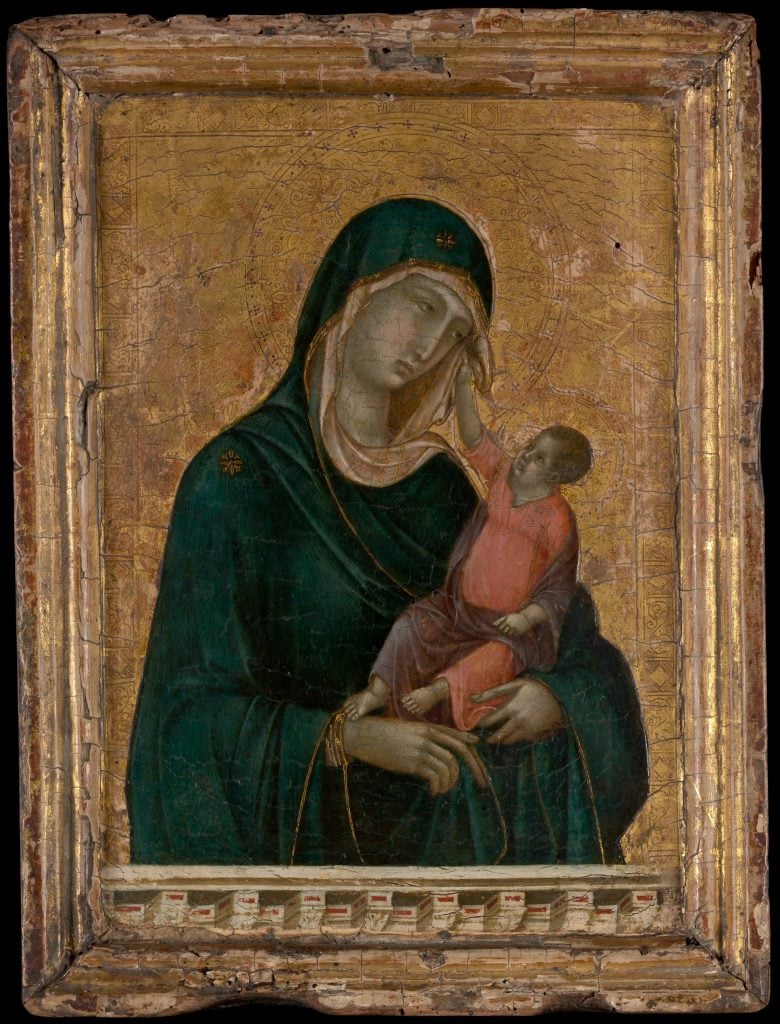
Duccio di Buoninsegna, Madonna and Child (1290-1300). Courtesy: Metropolitan Museum of Art
“The extraordinary variety of the surviving scenes can only be appreciated fully when they are seen together,” Imogen Tedbury, a curator of pre-1500 Italian paintings at the National Gallery in London, writes in the catalog. “Their varying terrain, architectural structures, and vivid gold skies undulating across their shared horizon assist the viewer in finding connections between episodes.”
In his Artnet essay, Ben described the panels as “graceful, concentrated images of Bible scenes.” He added that “they seem a little gawky now—charmingly so, to my mind—but their notes of imaginative proto-naturalism would grow and grow in influence.”
I ran into Simon at the opening reception for the exhibition and asked what he thought of the show, which will travel to the National Gallery in London next year.
“It’s the most phenomenal exhibition of early Italian painting that I can remember,” he said.
The paintings had to travel to New York sealed in their own “environments,” Wolohojian, the co-curator, said. Packing and trucking had to be sophisticated as well.
“You can’t imagine the springs and the vibration sensors and all of the stuff in the crates in which they come,” he said. “We’re trying to keep these things from vibrating and rumbling. You know how you feel if you go over a pothole? You don’t want to have a 700-year-old painting jumping up and down.”
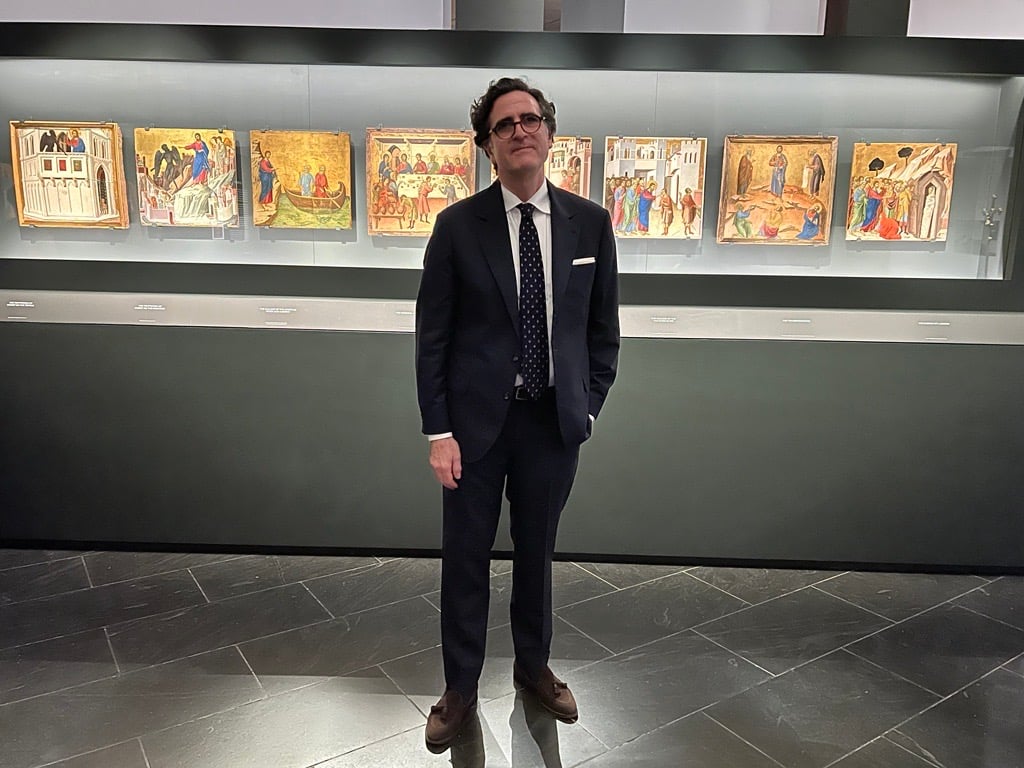
Stephan Wolohojian, curator in charge of European paintings at the Met. Photo by Katya Kazakina.
You certainly don’t want to have an insurance claim. Duccios are priceless. They are also very pricey.
When I asked Simon to estimate the insurance value for the show, he shrugged.
“The last Duccio in private hands that we know of sold for $45 million,” he said. “That was the most expensive painting the Met has ever bought. But those are old prices, that’s 20 years ago.”
Salvator Mundi, which Simon helped reattribute to Leonardo, fetched $450 million at auction in 2017. Of course, Duccio is not Leonardo, but his paintings have a history of selling for big prices over the past 100 years.
On November 19, 1927, the front page of the New York Times announced that Helen Clay Frick, a daughter of collector Henry Clay Frick (and a trustee of the Frick Collection), had acquired Duccio’s Temptation of Christ on the Mountain and the “Barna da Siena” Christ bearing the Cross for $500,000. The Duccio had been part of Robert Henry Benson’s preeminent collection of 115 early Italian paintings (from the 14th century to the 16th century), which included four of the missing Maestà panels.
![Dccio di Buoninsegna, Temptation of Christ on the Mountain (1308-11) [detail] at the Frick Madison. Photo by Ben Davis.](https://news.artnet.com/app/news-upload/2021/03/Duccio-The-Temptation-of-Christ-on-the-Mountain-detail-1024x993.jpg)
Duccio di Buoninsegna, Temptation of Christ on the Mountain (1308-11) [detail]. Photo by Ben Davis.
Benson’s collection had been acquired that same year by art dealer Joseph Duveen for $2.5 million, a staggering sum at the time. (Benson’s four Duccios have been loaned to Met by the Frick, the Thyssen-Bornemisza, NGA, and the Kimbell.)
The sale “marked the beginning of astronomical prices for gold-ground painting,” Tedbury, of London’s National Gallery, writes in the catalog.
What kind of horse-trading went on behind the scenes to obtain the loans?
“This is not a grab and go,” Wolohojian said. “This is serious scholarship, and serious investment, and serious collaboration.”
The Met is funding the first technical examination of the Maestà at a major conservation center in Florence. “This is obviously something that a small cathedral museum could never do,” Wolohojian said.
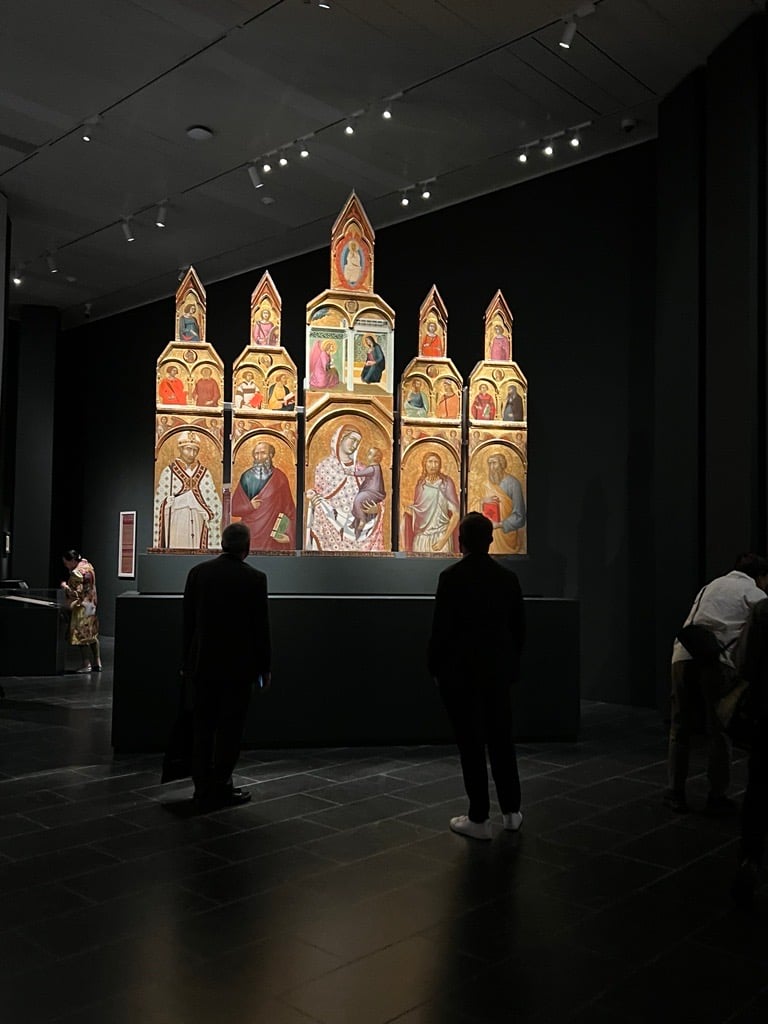
An installation view of Pietro Lorenzetti’s Pieve Polyptych at the Metropolitan Museum of Art. Photo: Katya Kazakina
Another meaningful collaboration began in 2017, when Wolohojian visited Arezzo to see Pietro Lorenzetti’s large-scale altarpiece at the Santa Maria della Pieve church. The 10-foot-by-10-foot polyptych was commissioned in 1320 and “marks the evolution of the altarpiece format in the wake of the Maestà in the hands of the next generation of Sienese artists,” scholars Donal Cooper and Andrea de Marchi write in the catalog.
The Met helped drum up support for a 10-year restoration of the piece, working closely with the city of Arezzo and its archdiocese. The breathtaking piece, disassembled for transport and reassembled in New York, looks like it was painted yesterday, its gold ground dazzling, its patterns and colors alive.
You have until January 26 to behold this singular show. Run, don’t walk.





